We have been hosting regular Zoom meet ups for our Fast Fashion Therapy friends who miss our regular workshops. During our first meet up the chat was dominated by questions on how to make a face mask. At that time the scientists were sitting on the fence as to whether home-made masks were effective against Covid-19. Our group felt that something is better than nothing and since then the UK Government recommend wearing them when social distancing isn’t possible to prevent the spread of the virus.
Luckily for us, friend of Fast Fashion Therapy, Karla was on the call. She had been busy making hundreds of masks for her daughter and colleagues who work at the Whittington hospital in London. Karla’s daughter wears a surgical grade mask during her shift but finds the home made face coverings useful on her journey to and from work.
We have cheated and not created our own make a mask video. There are so many great videos out there we thought we would share our favourites.
How to make a mask videos

This is Karla and her daughter, Dr Imogen Ptacek. Karla made a respirator Jesse Mask designed by The Fabric Patch.


Sarah made her mask from instructions by Leah Day, also recommended by Karla. However, when she ran out of elastic, she used this video by Tilly & The Buttons to create a mask that ties at the back instead of using elastic around the ears. Stitchless TV have video tutorials for both style of masks and recommend using a back stitch if you don’t have a sewing machine.
Fabric choices
Sarah and Karla chose a cotton poplin from their fabric stash that could withstand washing at 60oC. We have read that fabrics need to be washed with soap at this temperature to help breakdown the proteins of the virus. (We don’t recommend washing clothes at this temperature and always follow the advice in the care label). Poly-cotton is also a good fabric choice for this project. We recommend the fabric not being too thick as the masks contain two layers plus pleats on one of the versions. The wearer needs to be able to breathe through all that fabric. Old shirts, pillow cases and bed sheets are ideal materials to use. T-shirts or jersey fabric could also be used if it is first fixed with non-woven interfacing (which works as an additional filter). We have seen some people on Instagram use denim but think it could be a bit thick to breathe through.
Wire
Many of the tutorials recommend using wire to give the mask a closer fit around the nose. Sarah used a pipe cleaner bought from her local hardware store. Stitchless TV use garden wire and Tilly and The Buttons use a straightened out paper clip. If you are going to use a wire, Sarah recommends sewing a channel where the wire can be removed (as Till’s instructions). After washing at 60 degrees, Sarah’s wire has lost it’s shape and is no longer useful.
Filter
The pleated style masks have a gap to insert a filter. If you are going to use a filter then it needs to be a fused material, such as a piece of kitchen towel, j-cloths and squares of chopped up hoover bags (the fabric variety, not paper). The filter should be thrown away securely after each wear.
Important to note
All the videos note that the masks are not suitable in a clinical setting. The UK Government recommend wearing the masks when social distancing is not possible, e.g. on public transport. They could possibly stop the wearer spreading the virus to someone else but they probably do not protect the wearer from catching the disease. The mask must be washed after each wear. Place the mask over your mouth and nose before leaving home. Do not touch your face or remove the mask whilst out and about. Wash your hands thoroughly before touching your face to remove the mask. Place the mask in a drawstring bag and wash them both on a hot soapy wash.
